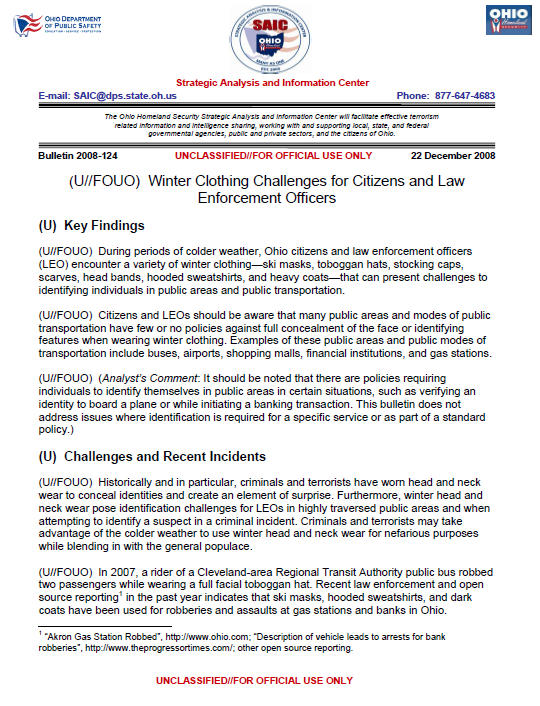 Ohio Strategic Analysis and Information Center
Ohio Strategic Analysis and Information Center
- 3 pages
- For Official Use Only
- December 22, 2008
(U) Key Findings
(U//FOUO) During periods of colder weather, Ohio citizens and law enforcement officers (LEO) encounter a variety of winter clothing—ski masks, toboggan hats, stocking caps, scarves, head bands, hooded sweatshirts, and heavy coats—that can present challenges to identifying individuals in public areas and public transportation.
(U//FOUO) Citizens and LEOs should be aware that many public areas and modes of public transportation have few or no policies against full concealment of the face or identifying features when wearing winter clothing. Examples of these public areas and public modes of transportation include buses, airports, shopping malls, financial institutions, and gas stations.
(U//FOUO) (Analyst’s Comment: It should be noted that there are policies requiring individuals to identify themselves in public areas in certain situations, such as verifying an identity to board a plane or while initiating a banking transaction. This bulletin does not address issues where identification is required for a specific service or as part of a standard policy.)
(U) Challenges and Recent Incidents
(U//FOUO) Historically and in particular, criminals and terrorists have worn head and neck wear to conceal identities and create an element of surprise. Furthermore, winter head and neck wear pose identification challenges for LEOs in highly traversed public areas and when attempting to identify a suspect in a criminal incident. Criminals and terrorists may take advantage of the colder weather to use winter head and neck wear for nefarious purposes while blending in with the general populace.
(U//FOUO) In 2007, a rider of a Cleveland-area Regional Transit Authority public bus robbed two passengers while wearing a full facial toboggan hat. Recent law enforcement and open source reporting1 in the past year indicates that ski masks, hooded sweatshirts, and dark coats have been used for robberies and assaults at gas stations and banks in Ohio.
(U) Current Policies
(U//FOUO) SAIC research which includes collaboration with partners and other resources2 indicates that few public areas—such as financial institutions, grocery stores, jewelry stores—or modes of transportation have policies prohibiting the concealment of identities with winter weather clothing (this does not include private businesses which can enact their own policies). The Ohio Bureau of Motor Vehicles, for example, does have a policy that requires the removal of headwear for identification in driver license and state ID photographs (except for specified religious purposes or medical treatments). Some financial institutions are exploring policies that would require individuals to remove all concealing headwear before entering the lobby area prior to a transaction. The policy would give employees the opportunity to verbally confront any violators of the policy.
(U//FOUO) Officials cite public transportation driver and passenger safety as the main reason to implement a policy which would require an individual to remove head and neck wear that conceals an identity before entering, boarding, or using public transportation services. Identified Ohio transportation authorities have previously discussed measures to implement policies that would require individuals to remove winter weather clothing, such as ski masks and toboggans, when boarding a public bus or utilizing public transportation. In the past, legal and enforcement issues have impeded the implementation of these kinds of policies, and discussions are ongoing at this time.
(U) Conclusion
(U//FOUO) Only a very small percentage of individuals use winter weather clothing for criminal or terrorist purposes. Individuals who transit public areas and ride public transportation may become alarmed or uneasy when they observe others with this type of concealment because of preconceived notions and perceptions. As discussion continues about the implementation of proposed policies, citizens and LEOs are reminded to remain vigilant of the challenges winter clothing may pose in public areas and public transportation.
